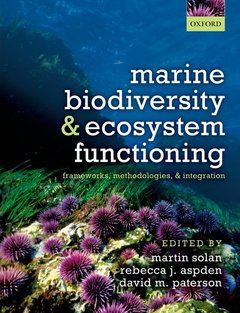Description
Marine Biodiversity and Ecosystem Functioning
Frameworks, methodologies, and integration
Coordinators: Solan Martin, Aspden Rebecca J., Paterson David M.
Language: English
Subjects for Marine Biodiversity and Ecosystem Functioning:
Marine biodiversity and ecosystem functioning: frameworks, methodologies, and integration (paperback)
Publication date: 07-2012
254 p. · 19.1x24.5 cm · Paperback
Publication date: 07-2012
254 p. · 19.1x24.5 cm · Paperback
Marine biodiversity and ecosystem functioning: frameworks, methodologies, and integration
Publication date: 07-2012
254 p. · 19.7x24.7 cm · Hardback
Publication date: 07-2012
254 p. · 19.7x24.7 cm · Hardback
Description
/li>Contents
/li>Biography
/li>
The biological composition and richness of most of the Earth's major ecosystems are being dramatically and irreversibly transformed by anthropogenic activity. Yet, despite the vast areal extent of our oceans, the mainstay of research to-date in the biodiversity-ecosystem functioning arena has been weighted towards ecological observations and experimentation in terrestrial plant and soil systems. This book provides a framework for extending these concepts to a variety of marine systems. Marine Biodiversity and Ecosystem Functioning is the first book to address the latest advances in biodiversity-function science using marine examples. It brings together contributions from the leading scientists in the field to provide an in-depth evaluation of the science, before offering a perspective on future research directions for some of the most pressing environmental issues facing society today and in the future.
1. Marine biodiversity: its history, present status and future threats. 2. Biodiversity in the context of ecosystem function. 3. Ecosystem function and co-evolution of terminology in marine science and management. 4. Ecological consequences of declining biodiversity: A biodiversity-ecosystem function (BEF) framework for marine systems. 5. Lessons from the fossil record: the Ediacaran radiation, the Cambrian radiation, and the end-Permian mass extinction. 6. The analysis of biodiversity-ecosystem function experiments: partitioning richness and density-dependent effects. 7. The importance of body size, abundance, and food web structure for ecosystem functioning. 8. Effects of biodiversity-environment conditions on the interpretation of biodiversity-function relations. 9. Extending the approaches of biodiversity and ecosystem functioning to the deep ocean. 10. Incorporating extinction risk and realistic biodiversity futures: Implementation of trait based extinction scenarios. 11. Biodiversity and ecosystem functioning: an ecosystem-level approach. 12. Multitrophic biodiversity and the responses of marine ecosystems to global change. 13. Reality check: issues of scale and abstraction in biodiversity research, and potential solutions. 14. Why bother going outside: the role of observational studies in understanding biodiversity-ecosystem function relationships. 15. Implementing an ecosystem approach: predicting and safeguarding marine biodiversity futures. Index.
Martin Solan is a marine benthic ecologist with broad interests in understanding biodiversity-environment interactions and the ecosystem consequences of altered diversity and environmental change. A key component of his research has been the development of in situ marine technology for the observation of organism-sediment relations, enabling changes in invertebrate behaviour to be related to environmental conditions at the temporal and spatial scales at which they occur. The technologies he uses have been instrumental in understanding the contribution of past and present benthic communities to ecosystem functioning and have informed the design of complex manipulative laboratory and field experiments that seek to understand the ecological consequences of species loss. In establishing this area of research, he has been influential in modifying approaches originally developed in terrestrial grassland systems for marine benthic environments. Beccy Aspden is currently a post doctoral research assistant at the University of St. Andrews, Scotland. She graduated from the University Plymouth in 2000 with a BSc in Marine Biology and Coastal Ecology. During August 2000 she carried out an internship at the Alfred Wegner Institute in Sylt, Germany, studying the effects of a tube building polychaete reef on the sediment and faunal diversities within and surrounding it. During the next 12 months she worked for a marine and freshwater consultancy agency (Unicomarine Ltd), during which she undertook the identification of invertebrate fauna found within samples taken for various contracts. These contracts included port development and dredging, coastal protection, fishery studies, and habitat surveys. Dr Aspden joined the Sediment Ecology Research Group (University St Andrews) in 2001 to complete her Ph.D. David Paterson is Head of the School of Biology at the University of St. Andrews and Director of the Sediment Ecology Research Group. He obtained his Ph.D. from the University of
© 2024 LAVOISIER S.A.S.




